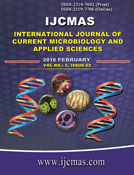


 National Academy of Agricultural Sciences (NAAS)
National Academy of Agricultural Sciences (NAAS)

|
PRINT ISSN : 2319-7692
Online ISSN : 2319-7706 Issues : 12 per year Publisher : Excellent Publishers Email : editorijcmas@gmail.com / submit@ijcmas.com Editor-in-chief: Dr.M.Prakash Index Copernicus ICV 2018: 95.39 NAAS RATING 2020: 5.38 |
Urinary tract infection (UTI) represents one of the most common diseases encountered in medical practice today, occurring from the neonate to the geriatric age group. Urinary tract infection (UTI) can be caused by Gram-negative bacteria such as Escherichia coli, Klebsiella species, Enterobacter species, Proteus species and gram-positive bacteria like Enterococcus species, and Staphylococcus saprophyticus. This study was conducted to know the uropathogens and trend of antibiotic susceptibility pattern of uropathogens in our setting, thus can help in deciding empirical treatment of UTI. This retrospective study was carried out in the Department of Microbiology, MIMS, Mandya. The urinary pathogens and their antibiotics susceptibility patterns from January - December 2014( One year) were studied from the records of Microbiology laboratory. A total of 357 urine samples were processed. Among them, 127 (35.5%) samples yielded significant growth. Among 110 samples from males, 30 ( 27.2%) yielded significant growth, majority yielded Escherichia coli 18(60%) followed by Staphylococcus aureus 3(10%), Candida 3(10%), Pseudomonas aeruginosa 2(6.7%), Citrobacter 2(6.7%) and Klebsiella 2(6.7%). Among 247 samples from females, 97 (39.2%) yielded significant growth, majority yielded Escherichia coli 34 (35%) followed by Staphylococcus aureus 16 (16.4%), CONS 11(11.3%), Klebsiella 10(10.3%), Candida 9(9.3%), Enterococci 8 (8.2%), Acinetobacter 5(5.1%), Citrobacter 3(3%), and Morganella 1(1%). Prevalence of UTIs was more in females(39.2%) when compared to males(27.2%). In our study E.coli was most resistant to Ampicillin (96.2%). It was most sensitive to Imipenem (100%) followed by Piperaciliin-tazobactum (81.92%) . All the Gram positive bacteria were also highly resistant to ampicillin and showed 100% sensitivity to vancomycin. Urinary pathogens showed resistance to commonly used antibiotics like Ampicillin, Cotrimoxazole. The susceptibility patterns of urinary pathogens should be considered before starting empirical treatment for UTI.
 |
 |
 |
 |
 |